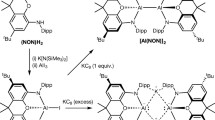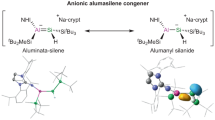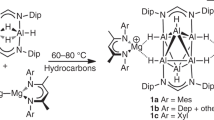Abstract
Aluminium tris(ethyl acetoacetate), Al(C6H9O3)3 has been prepared and characterized by means of 1H and 13C nuclear magnetic resonance spectroscopy, scanning electron microscopy and X-ray powder diffraction (XRPD). It was determined that two stereoisomeric complexes can be distinguished in the solution: meridional and facial. The crystal structure of Al(C6H9O3)3 has been determined from XRPD data. The compound crystallizes in the monoclinic space group P21/n.







Similar content being viewed by others
References
Kurajica S, Mali G, Gazivoda T, Sipusic J, Mandic V (2009) A spectroscopic study of calcium aluminate gels obtained from aluminium sec-butoxide chelated with ethyl acetoacetate in various ratios. J Sol–Gel Sci Technol 50:58–68
Nass R, Schmidt H (1990) Synthesis of an alumina coating from chelated aluminium alkoxides. J Non Cryst Solids 121:329–333
Mehrotra RC (1988) Chemistry of metal β-diketonates. Pure Appl Chem 60:1349–1356
Tadanaga K, Iwami T, Tohge N, Minami T (1994) Precursor structure and hydrolysis-gelation process of Al(O-sec-Bu)3 modified with ethylacetoacetate. J Sol–Gel Sci Technol 3:5–10
Hoebbel D, Reinert T, Schmidt H, Arpac A (1997) On the hydrolytic stability of organic ligands in Al-, Ti- and Zr-alkoxide complexes. J Sol–Gel Sci Technol 10:115–126
Lichtenberger R, Puchberger M, Baumann SO, Schubert U (2009) Modification of aluminum alkoxides with β-ketoesters: new insights into formation, structure and stability. J Sol–Gel Sci Technol 50:130–140
Lichtenberger R, Schubert U (2010) Chemical modification of aluminium alkoxides for sol–gel processing. J Mater Chem 20:9287–9296
Sakka S (2005) Handbook of sol–gel science and technology: processing characterization and applications. 1. Sol–gel processing. Kluwer, New York
Livage J, Henry M, Sanchez C (1988) Sol–gel chemistry of transition metal oxides. Prog Solid State Chem 18:259–341
Sanpo N, Wang J, Berndt CC (2013) Influence of chelating agents on the microstructure and antibacterial property of cobalt ferrite nanopowders. J Aust Ceram Soc 49:84–91
Wang SF, Zhang CF, Sun GA, Chen B, Xiang X, Ding QP, Zu XT (2014) Chelating agents role on phase formation and surface morphology of single orthorhombic YMn2O5 nanorods via modified polyacrylamide gel route. Sci China Chem 57:402–408
Abdullah NA, Osman N, Hasan S, Hassan OH (2012) Celating agents role on thermal characteristics and phase formation of modified cerate–zirconate via sol–gel synthesis route. Int J Electrochem Sci 7:9401–9409
Seyedahmadian M, Houshyarazar S, Amirshaghaghi A (2013) Synthesis and characterization of nanosized of spinel LiMn2O4 via sol–gel and freeze drying methods. Bull Korean Chem Soc 34:622–628
Marquez-Alvarez C, Zilkova N, Perez-Pariente J, Cejka J (2008) Synthesis, characterization and catalytic applications of organized mesoporous aluminas. Catal Rev 50:222–286
Altomare A, Camalli M, Cuocci C, Giacovazzo C, Moliterni A, Rizzi R (2009) EXPO2009: structure solution by powder data in direct and reciprocal space. J Appl Cryst 42:1197–1202
Altomare A, Camalli M, Cuocci C, Giacovazzo C, Moliterni A, Rizzi R (2011) EXPO2011: a new package for powder crystallography. Powder Diffr Suppl 26(S1):S2–S12
Altomare A, Campi G, Cuocci C, Eriksson L, Giacovazzo C, Moliterni A, Rizzi R, Werner PE (2009) Advances in powder diffraction pattern indexing: N-TREOR09. J Appl Cryst 42:768–775
Le Bail A, Duroy H, Fourquet JL (1988) Ab initio structure determination of LiSbWO6 by X-ray powder diffraction. Mater Res Bull 23:447–452
Kempster CJE, Lipson H (1972) A rapid method for assessing the number of molecules in the unit cell of an organic crystal. Acta Cryst B 28:3674
Djerdj I, Popović J, Stare J, Ambrožić G, Škapin S, Kozlevčar B, Pajić D, Jagličić Z, Crnjak Orel Z (2012) Nanocrystalline hybrid inorganic-organic one-dimensional chain systems tailored with 2 and 3-phenyl rings monocarboxylic acids. J Mater Chem 22:10255–10265
Kresse G, Furthmuller J (1996) Efficient iterative schemes for ab initio total-energy calculations using a plane-wave basis set. J Phys Rev B 54:11169–11186
Perdew JP, Burke K, Ernzerhof M (1996) Generalized gradient approximation made simple. Phys Rev Lett 77:3865–3868
Blochl PE (1994) Projector augmented-wave method. Phys Rev B 50:17953–17979
Methfessel M, Paxton AT (1989) High-precision sampling for Brillouin-zone integration in metals. Phys Rev B 40:3616–3621
Monkhorst HJ, Pack JD (1976) Special points for Brillouin-zone integrations. Phys Rev B 13:5188–5192
Zanello P, de Bianai FF, Glidewell C, Koenig J, Marsh SJ (1998) Isomerism and redox properties of 1-ferrocenyl1,3-butanedionate complexes. Polyhedron 17:1795–1801
von Chrzanowski LS, Lutz M, Spek AL (2006) γ-Tris(2,4-pentanedionato-κ2O,O′)aluminium(III) at 110 K. Acta Cryst E62:m3318–m3320
von Chrzanowski LS, Lutz M, Spek AL (2007) α-Tris(2,4-pentanedionato-κ2O, O′)aluminium(III) at 240, 210, 180, 150 and 110 K: a new δ phase at 110 K. Acta Cryst C63:m129–m134
Brown ID, Wu KK (1976) Empirical parameters for calculating cation-oxygen bond valences. Acta Crystallogr Sect B Struct Crystallogr Cryst Chem 32:1957–1959
Acknowledgments
The financial support of the Ministry of Science, Education and Sports of Republic of Croatia and University of Zagreb is gratefully acknowledged. We would like to thank Dr. Caterina Chiarella for technical contribution.
Author information
Authors and Affiliations
Corresponding author
Electronic supplementary material
Below is the link to the electronic supplementary material.
Supplementary data
Supplementary data
Crystallographic data for the reported Al(Eaa)3 structure have been deposited with the Cambridge Crystallographic Data Centre as supplementary publication No. CCDC 961440.
Rights and permissions
About this article
Cite this article
Kurajica, S., Popović, J., Gazivoda Kraljević, T. et al. A structural investigation of tris(ethyl acetoacetate)aluminium (III). J Sol-Gel Sci Technol 71, 217–223 (2014). https://doi.org/10.1007/s10971-014-3345-1
Received:
Accepted:
Published:
Issue Date:
DOI: https://doi.org/10.1007/s10971-014-3345-1




